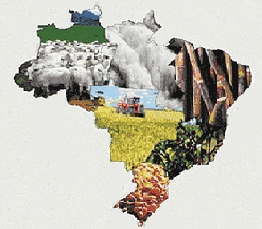Thinking of the Brazilian agricultural sector, some facts to consider:
Over the past 20 years, the country jumped from self-sufficient and even a net importer of various agricultural products to the position of net exporter of agribusiness, transforming the dynamics of global trading, before mainly led by the United States and European Union. From 1993 to 2013, the national grain production increased from 68.0 million tons to 186.9 million tons, while the balance of agricultural exports showed an annual average growth of 13%, totaling US$ 100.6 billion in 2013, with a market share gain of 34%.
As to animal protein, the country currently represents 19% of all beef exported worldwide, 35% of chicken meat and 9% of pork, considering not only variables such as population growth and per capita income, but also expanding the offer to meet new countries, previously supplied by other economies or that didn’t have a relevant meat consumer profile. These and other events have had a direct influence on agricultural technological improvement in the average yield increase and, ultimately, in our Ag GDP (R$ 648 billion 20 years ago to about R$ 1 trillion in 2013).
From 1994 to the present period, the Brazilian population grew close to 30%, while the national grain production expanded 160%, under mechanical and biochemical innovations. Much of the resulting surplus production aimed the international market.
None of this would have been possible, however, without innovative techniques implemented to improve both products and agricultural management, and especially without the proper commitment of companies involved in the creative process. Good management practices are critical to any business, no different in agriculture.
What is observed in Brazil is that the agribusiness progress had (and still has) different contributions from its five regions (North, Northeast, Midwest, Southeast and South). The advanced technology in production is concentrated in the South-Centre area, while the North and Northeast are currently facing expansion of new agricultural frontiers.
This means that several regions in the same territory are in different agricultural moments. It is as if we could make historical analysis of what happened in the state of Mato Grosso 30 years ago, with the planting of soybeans, for example, and a similar process being replicated today in the state of Sergipe, but with maize.
Just as an example of this evolutionary gap, the National Supply Company (Conab), estimates for the 2014/15 crop season the following yields for Brazilian grain production (cotton seed, peanuts, rice, hazelnuts, rye, barley, sunflower, castor beans, corn, soybeans, wheat and triticale):
Region Yield (kg/hectare)
North 3,193
Northeast 2,143
Midwest 3,798
Southeast 3,780
South 3,565
This means that while the Northeast reaches an average yield of 2,143 kg/hectare, its neighbor, Midwest region, gets almost 80% more for the same variable.
There are many points to be considered (soil and climate, cultural, political, socio-economic...) to explain why technology insertion can be so disparate in Brazilian regions that are so close to each other, but an important factor here is the difficulty of benchmarking in Brazil, especially among farmers. There is serious miscommunication inside the agricultural community, a situation that has been softened in recent decades, but still consistent.
If there is a barrier for Brazilian producers to understand the country's agricultural practices as a whole, imagine how difficult it must be to expand this vision worldwide. And here, in my view, Nuffield enters as an important agent capable of stimulating discussion, both internally and between the various nations already so active in the organization.
I’m sure that Nuffield will succeed in helping spread excellence in all aspects of agricultural production in Brazil, and has worked diligently for the country to feel inserted into this global network. Following the two final questions of the last post, I believe that the organization ideology in Brazil may stumble at a cultural concept: this is a big country, with farmers (and other professionals as well) that still have much to do to establish a fluent communication net. And also, to be the first international scholar in this program employs me a sense of responsibility in helping to connect these dots internally and globally, still fueling the possibility to include so many other countries. A very beautiful bridge is being built here, and I’m proud to be part of it.
Image courtesy of Embrapa
Sources:

Nenhum comentário:
Postar um comentário